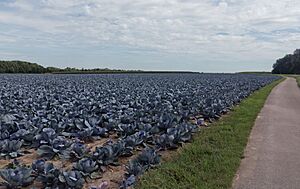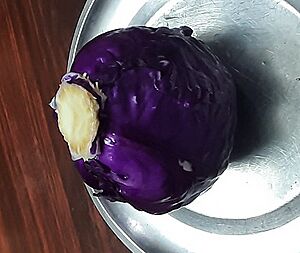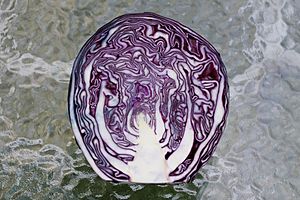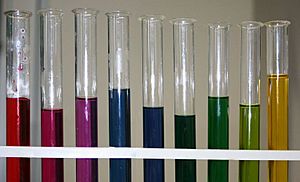Red cabbage facts for kids
Quick facts for kids Red cabbage |
|
|---|---|
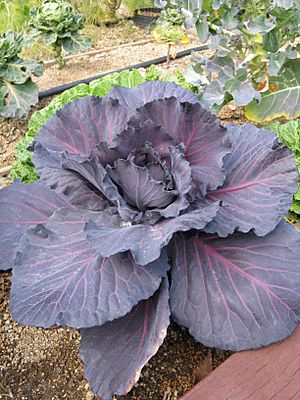
Red cabbage plant
|
|
| Species | Brassica oleracea |
| Cultivar group | Capitata Group |
The red cabbage is a colorful type of cabbage. It is also known as Blaukraut in some places, especially after it's cooked. Its leaves are usually a dark red or purple color.
But here's a cool fact: the plant can actually change its color! This happens because of a special coloring called anthocyanin. The color depends on the pH of the soil it grows in.
- In acidic soil, the leaves look more reddish.
- In neutral soil, they appear more purple.
- In alkaline soil, they might even look greenish-yellow!
This is why the same plant can be called by different colors in various regions. You can find red cabbage growing all over Europe, North and South America, China, and especially in Africa.
The juice from red cabbage can be used as a homemade pH indicator. This means it can show you if something is an acid or a base. It turns red in acid and green or yellow in basic solutions. When you cook red cabbage, it usually turns blue. To keep its pretty red color, you need to add something acidic like vinegar or fruit to the pot.
Red cabbage grows best in soil that has lots of nutrients and enough moisture. It's a seasonal plant. Farmers usually plant the seeds in spring and harvest the cabbage in late autumn. Red cabbage also stores better than its "white" relatives. It doesn't need to be turned into sauerkraut to last through the winter.
Contents
Cooking with Red Cabbage
Red cabbage is often used fresh in salads and coleslaw. It's also delicious when cooked. In Germany, it's a traditional side dish with many meals. You might see it served with meat dishes like Sauerbraten or Döner. Around Christmas, people often spice and braise it. It makes a great side for roast goose or turkey. Sometimes, apples are added to give it a sweet and sour taste.
Growing Red Cabbage
If you want to grow red cabbage, it's a good idea to start the seeds indoors. Do this about four weeks before the last frost of spring. Plant the seeds in small containers that allow water to drain out. Things like peat pots or egg cartons work well.
Once the little plants are about 2 inches (5 cm) tall, they will have their first true leaves. Then you can get them ready to move outside. Red cabbage likes cool, moist weather for most of its growing time. So, you can plant them in the ground shortly after the last frost, while spring is still cool.
Space your cabbage plants about 12 to 26 inches (30 to 66 cm) apart. They will need to be watered often. Other than that, they are pretty easy to take care of!
Red Cabbage as a pH Indicator
Red cabbage has a natural dye called anthocyanin. This dye can be used to test the pH of different liquids. It's like a natural litmus paper!
Here's how it works:
- In acids (liquids with a pH less than 7), the indicator turns red, pink, or magenta.
- In neutral solutions (liquids with a pH around 7), it turns purple.
- In alkaline solutions (liquids with a pH greater than 7), it changes from blue to green, and even to yellow.
Nutrition Facts
Cooked red cabbage is mostly water, about 91%. It has some carbohydrates (7%) and a little protein (1%). It has almost no fat.
Red cabbage is a great source of important vitamins! It has a lot of vitamin C and vitamin K. Just 100 grams (about 3.5 ounces) gives you 44% of the daily recommended amount of vitamin C. It also provides 72% of the daily recommended amount of vitamin K. It's also a good source of vitamin B6.
See also
 In Spanish: Lombarda para niños
In Spanish: Lombarda para niños


